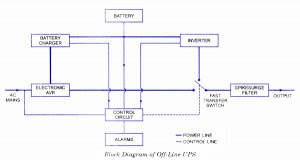Most of us take the mains ac supply for granted and use it almost casually without giving the slightest thought to its inherent shortcomings and the danger posed to sophisticated and sensitive electronic instruments/equipments. For ordinary household appliances such as incandencent lamps, tubes, fans, TV and fridge, the mains ac supply does not make much difference, but when used for computers, medical equipments and telecommunication systems, a clean, stable interruption free power supply is of the utmost importance. Of the myriad of devices, processes and systems which rely on ac power, computers are probably the most sensitive to power disturbances and failures. Interruptions in power supply may cause the contents of a memory to be lost or corrupted, the entire system to malfunction or fail, or even variety of components failures to occur, all of which not only result in inconvenience but also loss of money.
As more and more PCs, word processors and data terminals find their way into small business, UPS systems that meet the power requirements and price range needs of even the small business organizations and offices are being manufactured.
Un-interruptable Power Supply Systems.
There are three distinct types of uninterrupted power supplies, namely, (£) on-line UPS (ii) off-line UPS, and (Hi) electronic generators. In the on-line UPS, whether the mains power is on or off, the battery operated inverter is on all the time and supplies the ac output voltage. When the mains power supply goes off, the UPS will be on only until the battery gets discharged. When the main power resumes, the battery will get charged again. In off-line UPS and electronic generators, ther inverter is off when the mains power is present and the output voltage derived directly from the mains is the same as the mains supply voltage. The inverter turns on only when the mains supply goes off.
The block diagrams of on-line UPS, off-line UPS and electronic generators are given in figs
The ever increasing importance of computers in industry and commerce will increase the need for quality, high stability and interruption free power supplies.
A clean ac power source is the fundamental to the operation of most sensitive electronic equipment, and many new and sophisticated circuits are designed to overcome the effects of disturbances normally found in the mains ac supply.
In order to protect a sensitive system from power losses and blackouts, an alternative power source is required that can switch into operation immediately when disruption occurs. An interruptable power supply (UPS) is just such an alternative source. A UPS generally consists of a rectifier, battery charger, a battery bank and inverter circuit which converts the commercial ac input into dc suitable for input to the battery bank and the inverter. The rectifier should have its input protected and should be capable of supplying power to the inverter when the commercial supply is either slightly below the normal voltage or slightly above.
Online UPS:(Block Diagram)
In case of On-line UPS, the battery operated inverter works continuously whether the mains supply is present or not. Triac T1 is on for all the times while Triac T2 has been provided to bypass the UPS inverter, only when a fault develops in the UPS inverter. When the mains supply fails, the UPS supplies power only until the batteries get discharged. However, once the mains power resumes, the batteries will get charged again. The switching times of these supplies is considered to be zero. Usually sealed maintenance free batteries are used and the running time of the inverter is low (approximately 10 to 30 minutes).
Offline UPS:(Block Diagram)
In the case of Off-Line UPS, the inverter is off when the mains power is on and the output voltage is derived directly from the mains. The inverter turns on only when the mains supply fails. Its switching time is less than 5 ms. These UPS are generally used with PCs or computers or other appliances where a small duration (5 ms or less) interruption in power supply can be tolerated. Usually, sealed batteries or lead-acid batteries are used. The running time of these supplies is also low (about 10 to 30 minutes).
Electronic Generator:
The demand is the highest for the electronic generators meant for house hold applications, followed by the off-line UPS, and then the on-line UPS systems. The off-line or online UPS systems are mainly used in places where PCs or computers are used. The demand for on-line UPS systems is less than for off-line UPS systems because the price of the on-line UPS systems is higher.




EmoticonEmoticon